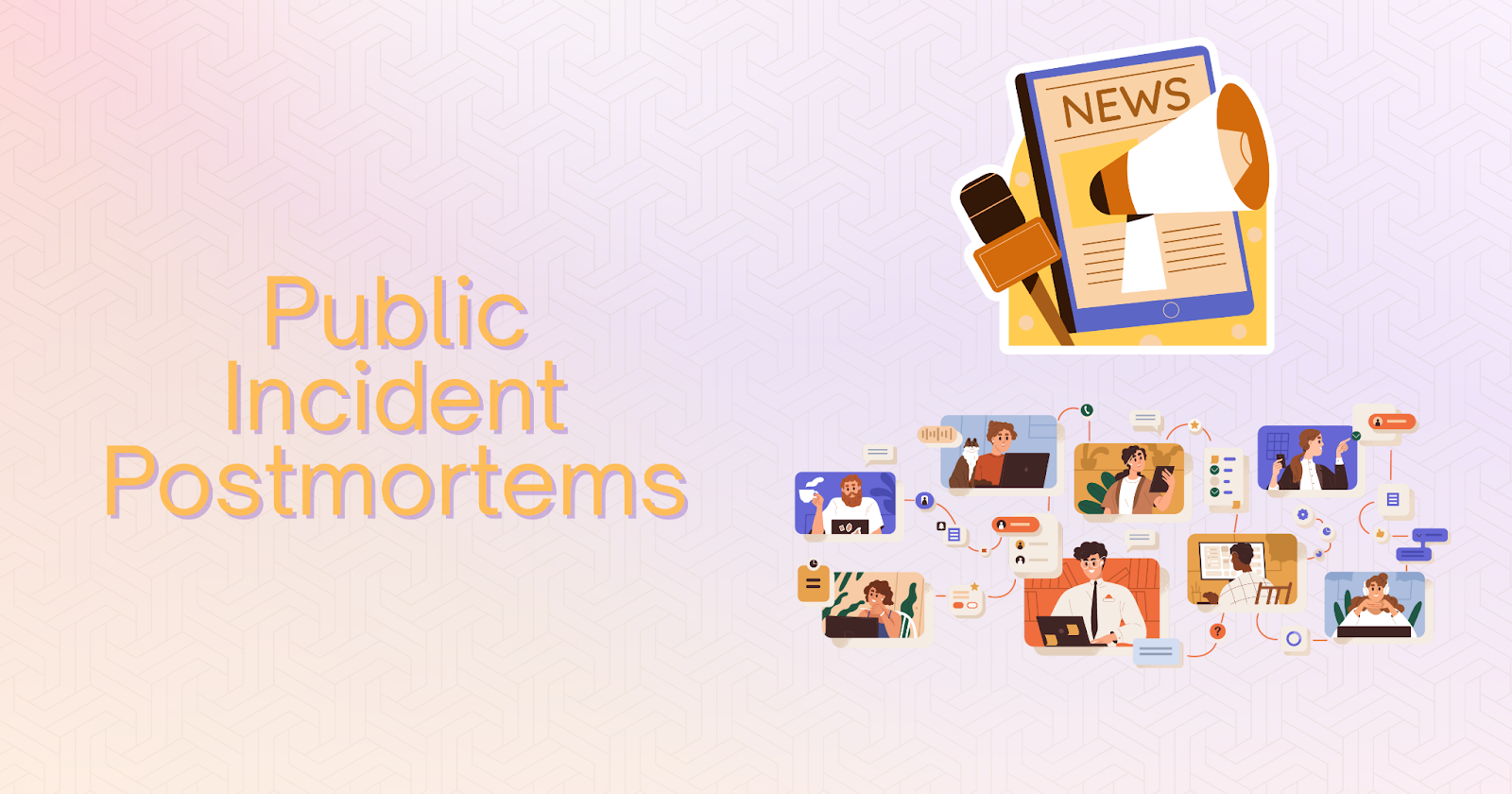Every post-incident review raises a crucial question. Should the postmortem remain internal, or should part of it be shared beyond the walls of the engineering team?
Public and private postmortems serve different purposes. Internal reports are designed for deep analysis, full transparency, and technical accuracy across engineering, product, and support. Public-facing versions prioritize clarity, reassurance, and accountability for users, partners, and external stakeholders.
The decision to go public or stay private influences how your team reflects on failure, how your organization is perceived, and how much risk is introduced through transparency. It is a decision that affects legal exposure, customer trust, and long-term reliability culture.
Choosing the right level of visibility requires more than instinct. It depends on impact, audience, and readiness to communicate with care. Knowing when to keep postmortems private and when to share them publicly is a critical part of building trust in how your team handles failure.
KeyTakeaways:
- Private postmortems are detailed, candid, and internal-focused—ideal for technical learning and system improvement.
- Public postmortems prioritize clarity, accountability, and trust, especially during major outages or customer-impacting incidents.
- Legal and reputational risks must be managed when going public—review, redaction, and collaboration are critical.
- Internal visibility policies help scale learning across teams and prevent siloed knowledge.
- Blameless, structured communication signals maturity and builds long-term trust—internally and externally.
Public vs. Private Postmortems: Key Differences
The structure, tone, and intended audience of a postmortem determine how much detail it contains, how it’s reviewed, and where it is published. While both internal and public versions aim to support accountability and learning, they operate under different constraints and serve different functions.
Understanding these distinctions ensures that teams communicate with the right level of context, reduce unnecessary risk, and align with broader goals around transparency and reliability.
What Makes a Postmortem Private?

Private postmortems are optimized for internal collaboration and technical clarity. They are often detailed, informal, and written primarily for peers across engineering, SRE, support, and product teams.
- Audience: Internal teams only
- Language: Technical, candid, context-rich
- Purpose: Improve system reliability, uncover blind spots, drive internal alignment
- Strengths:
- Encourages open discussion of root causes
- Supports deeper retrospectives with full system context
- Protects sensitive infrastructure details and decision-making processes
- Typical use: Low- to medium-impact issues, non-customer-facing incidents, internal process breakdowns
What Defines a Public Postmortem?

Public-facing postmortems are crafted with external stakeholders in mind. They strike a balance between transparency and discretion, aiming to communicate clearly without exposing sensitive details or introducing unnecessary risk.
- Audience: Customers, media, business partners, regulators
- Language: Plain, accessible, reviewed for legal and reputational risk
- Purpose: Communicate impact, show accountability, maintain trust
- Strengths:
- Demonstrates operational maturity and transparency
- Reduces speculation and misinformation during public-facing incidents
- Strengthens customer confidence and long-term brand perception
- Typical use: Major outages, contractual obligations, user-visible service disruptions, reputational events
When Should a Postmortem Be Shared Publicly?
Not every incident requires a public explanation. But when user trust is on the line or external visibility is unavoidable, sharing a postmortem becomes part of the incident response itself. Knowing when to move beyond internal documentation helps teams communicate with purpose rather than react under pressure.
Triggers for Going Public
Certain types of incidents naturally warrant broader visibility. Here are the most common scenarios where publishing a public-facing postmortem is not just helpful—it is expected.
Widespread Customer Impact
If an outage affects a large portion of users, particularly in production environments or across multiple regions, customers will be looking for answers. A public postmortem helps clarify what happened, what has been fixed, and what will be done to prevent recurrence. This is especially important for B2C platforms, APIs, or tools embedded in customer workflows.
Media or Social Coverage
Once an incident reaches external platforms like Twitter, LinkedIn, or news outlets, the narrative quickly shifts beyond your control. Publishing a clear, factual report on your status page or blog helps correct misinformation and shows that the team is taking ownership of the issue.
Contractual or Regulatory Obligations
Enterprise contracts, compliance frameworks (like SOC 2 or ISO 27001), or data protection regulations may require formal incident reporting. In some cases, a postmortem serves as the official record for auditors, partners, or customers who depend on your platform’s availability and integrity.
Trust and Reputation Strategy
Developer-first tools, cloud platforms, and infrastructure providers often choose transparency as part of their brand identity. Publishing postmortems is a deliberate strategy to build long-term trust. Organizations like GitHub, Vercel, and Stripe routinely share outage reports—even when the legal or contractual need is low—because they understand the reputational value of consistency and accountability.
Examples of Effective Public Postmortems
Case Study 1: Incident on a Developer SaaS Tool
A CI/CD platform faced a global pipeline outage for 4 hours. Their postmortem, published on their status page, included:
- A 5-bullet incident timeline
- What customers may have seen (e.g., failed builds)
- A high-level root cause (a database schema migration that locked writes)
- Recovery actions
- A new rollback checklist policy
Why it worked: Clear, humble, no over-promises. Timely and honest.
Case Study 2: Cloud Infrastructure Provider
A public cloud vendor published a technical breakdown of a regional outage on their engineering blog. It included:
- Links to internal metrics (anonymized)
- Details on cascading failures between zones
- Mitigation efforts by team roles (without naming individuals)
- Commitments for longer-term redundancy
Why it worked: Balanced technical detail with user-first framing. Maintained credibility without blame.
Risks of Public Postmortems (and How to Manage Them)
Publishing a postmortem can strengthen user trust—but only when handled with care. Without the right process, external reports can unintentionally introduce legal risk, expose sensitive systems, or erode confidence instead of reinforcing it.
Common Pitfalls
- Exposing sensitive architecture
Well-meaning transparency can backfire when technical diagrams, logs, or stack details reveal internal systems, service topology, or potential attack surfaces. Even seemingly minor details can pose risks when combined with other public data.
- Admitting legal liability
Postmortems written too quickly or without review may include speculative statements that imply fault or violate regulatory commitments. Language that seems harmless to engineers can create compliance concerns when viewed by legal teams, partners, or the public.
- Inaccuracy under pressure
Publishing before fully completing the investigation can spread incorrect assumptions or overlook contributing factors. Once shared externally, these versions are difficult to retract and may lead to follow-up scrutiny.
How to Mitigate
- Loop in legal and communications early
Involve legal, PR, and customer support teams during the postmortem review process, not just at the end. Early collaboration leads to clearer, safer messaging and avoids last-minute redlines.
- Redact and summarize thoughtfully
Avoid copy-pasting internal reports into public channels. Distill key takeaways in terms of user experience, resolution steps, and follow-up actions. Omit or generalize architectural references unless cleared for publication.
- Treat it like a product release
Use version control, peer review, and sign-off workflows before publishing externally. Public postmortems should follow the same discipline as software releases to protect quality and accountability.
Internal Visibility Policies: Who Sees What and When?
While public communication is one layer of transparency, internal visibility is just as critical. Effective postmortem processes ensure that the right people have access to the right insights—without creating bottlenecks or silos.
Postmortem Ownership and Responsibilities
Authoring
The initial draft is usually created by the on-call engineer, incident commander, or the team most familiar with the event timeline and technical details.
Reviewing
Before finalization, SRE leads, product managers, and other involved teams review the report for accuracy, completeness, and clarity. If the postmortem will be shared externally, communications and legal teams are included in the loop.
Approving
Larger organizations often have a postmortem review committee or engineering leadership responsible for final sign-off. Smaller teams may rely on peer reviews or role-based approvals.
Scaling Internal Visibility
- Use incident management platforms or internal dashboards to centralize access
- Publish postmortems to a searchable internal wiki, engineering blog, or knowledge base
- Encourage cross-team access, including support, QA, and leadership
- Treat postmortems as shared assets, not siloed documentation
Building habits of visibility creates a stronger learning culture across the organization.
How to Structure a Public Postmortem (Without Over-Sharing)
Clear structure makes a public postmortem easier to understand—and easier to trust. Teams should aim to explain what happened, what was done to resolve it, and what steps will prevent similar issues in the future, without revealing unnecessary or risky internal details.
What to Include in a Public Report
- A brief timeline of user-visible events
- What users may have experienced, including error types or degraded performance
- A high-level explanation of the root cause
- Actions taken to resolve the issue
- Next steps for prevention or improvement
What to Leave Out
- Names of individual engineers or specific internal teams
- Sensitive infrastructure details such as IP addresses, hostnames, or security configurations
- Raw logs, detailed error traces, or configuration files
- Emotionally charged or blame-oriented language
Every line of a public postmortem should reflect control, clarity, and care.
Where to Publish Public Postmortems
Choosing the right channel depends on who needs to see the report and how you want it to be found.
Best Channels for Visibility and Trust
Status page
Best for fast, incident-specific communication. Ideal for active users monitoring uptime or service availability.
Engineering blog
Useful for deeper technical insights. Helps build trust with developer audiences, platform teams, and industry peers.
Company blog or newsroom
Effective for communicating to a broader audience. Useful when incidents affect customers, investors, or brand reputation.
Social or press updates
Use social media or PR only to point readers to the full report. Avoid summarizing complex incidents in short-form posts.
Make sure whatever channel you use is easy to access, easy to link to, and clearly archived for future reference.
Best Practices for Blameless Communication (Both Internal and External)
The way you write a postmortem reflects the culture of your team. Whether internal or public, communication should center on learning, not judgment.
- Focus on systems and decisions, not individuals or roles
- Use calm, precise language—especially when tensions are high
- Avoid phrases that imply carelessness, like “someone forgot” or “engineer failed”
- Reinforce the goal of postmortems as tools for continuous improvement
Blameless communication is not about avoiding responsibility. It is about creating the psychological safety needed for honest reflection and better reliability.
Transparency Is a Reliability Signal
Public vs. private isn’t a binary choice—it’s a strategic one. Defaulting to private keeps your teams safe to learn. Choosing to go public, when done well, signals confidence, accountability, and operational maturity.
Every postmortem—whether shared internally or posted for the world—shapes how your team improves, how your users trust you, and how your platform evolves. Choose transparency intentionally, not reactively.
At Rootly.com, we support teams in building scalable, blameless postmortem workflows—whether private, public, or both. Transparency works best when it’s intentional, not reactive.
.avif)























